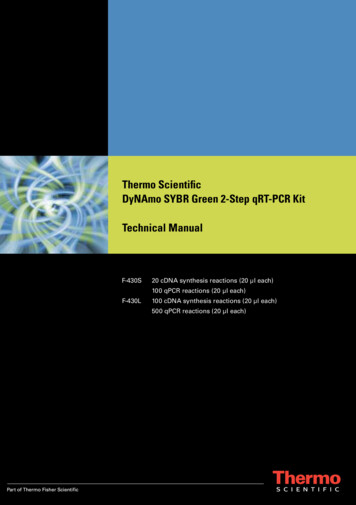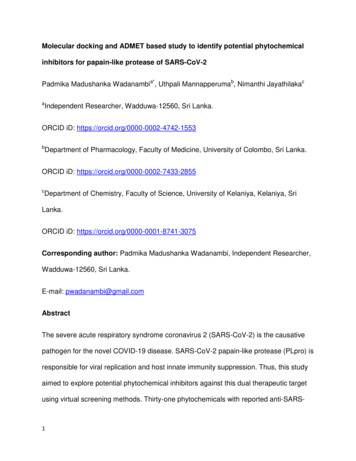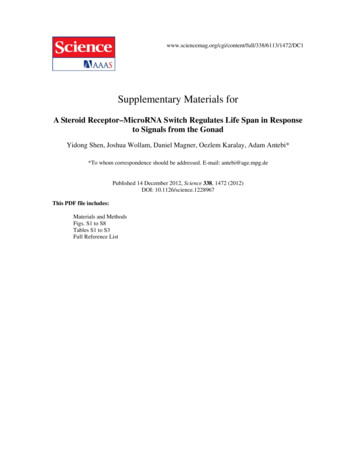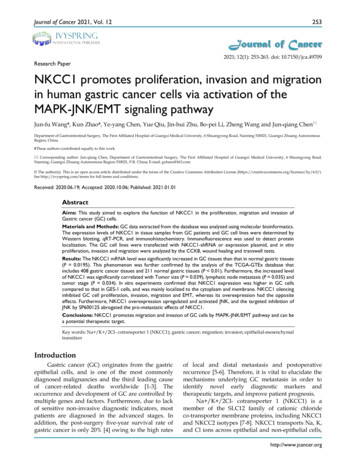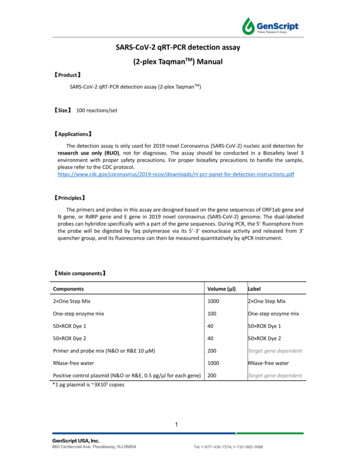
Transcription
SARS-CoV-2 qRT-PCR detection assay(2-plex TaqmanTM) Manual【Product】SARS-CoV-2 qRT-PCR detection assay (2-plex TaqmanTM)【Size】 100 reactions/set【Applications】The detection assay is only used for 2019 novel Coronavirus (SARS-CoV-2) nucleic acid detection forresearch use only (RUO), not for diagnoses. The assay should be conducted in a Biosafety level 3environment with proper safety precautions. For proper biosafety precautions to handle the sample,please refer to the CDC .pdf【Principles】The primers and probes in this assay are designed based on the gene sequences of ORF1ab gene andN gene, or RdRP gene and E gene in 2019 novel coronavirus (SARS-CoV-2) genome. The dual-labeledprobes can hybridize specifically with a part of the gene sequences. During PCR, the 5’ fluorophore fromthe probe will be digested by Taq polymerase via its 5’-3’ exonuclease activity and released from 3’quencher group, and its fluorescence can then be measured quantitatively by qPCR instrument.【Main components】ComponentsVolume (μl)Label2 One Step Mix10002 One Step MixOne-step enzyme mix100One-step enzyme mix50 ROX Dye 14050 ROX Dye 150 ROX Dye 24050 ROX Dye 2Primer and probe mix (N&O or R&E 10 μM)200Target gene dependentRNase-free water1000RNase-free waterPositive control plasmid (N&O or R&E, 0.5 pg/μl for each gene)200Target gene dependent*1 pg plasmid is 3X105 copies1
Primer, probe, positive controlN and ORF1ab genePrimer/Probe/PlasmidVol(μl)Primer and probe mix (10 μM)Primer and probe mix (N&O)200Positive control plasmid(0.5 pg/μl)Positive control plasmid (N&O) 200Primer and probe mix(N&O)Positive control plasmid(N&O)RdRP and E genePrimer/Probe/PlasmidVol(μl)Label namePrimer and probe mix (10 μM)Primer and probe mix (R&E)200Positive control plasmid(0.5 pg/μl)Positive control plasmid (R&E)200Primer and probe mix (R&E)Positive control plasmid(R&E)Label name【Storage condition and shelf-life】Shipping temperature 2 8 . Store at -20 5 away from light, avoid freeze and thaw. Expire 6 monthsafter production date.【Instrument】ABI Real-Time PCR Thermal Cyclers with FAM, VIC, ROX Channel.Instrument compatibility:qPCR instrumentDye selectionABI 7900HT/7300 real time PCR system, and StepOne PlusDye 1ABI 7500, 7500 fast real-time PCR system, StratageneMx3000PRoche, Biorad series of real time PCR systemDye 2No need of dye referenceCompatibility unknown. Pilot studyOther modelsrecommended【Sample requirement】1. Sample: Virus RNA2. Storage: 24hr under 2-8 3 months under -20 long-term storage under -70 and avoid freeze-thaw2
3. Shipping:Sealed foam box with blue ice or dry shipper【Methods】1.Reaction mix(in reagent preparation area)Thaw reagents at room temperature. Centrifuge at 1000 rpm for 15 sec, please in a sterile hood.For each reaction, mix the components below:Reaction mixVol (μl)/Reaction2 One Step Mix10One-step enzyme mix150 ROX Dye 1/2*0.4Primer and probe mix (N&O or R&E, 10 μM)2RNase-free water4.6Total volume18* Recommended 50 ROX Dye based on instrument type:1) ABI 7900HT/7300 Real-Time PCR System and StepOne Plus, use 50 ROX Dye 12) ABI 7500, 7500 Fast Real-Time PCR System, Stratagene Mx3000P, use 50 ROX Dye 22.Sample preparation(In sample preparation area)2.1 Nucleic acid extractionPlease refer to the protocol of the corresponding RNA extraction kit.2.2 Sample loadingAdd 2μl of the testing sample, positive control plasmid (ORF1ab gene and N gene, or RdRP geneand E gene), negative control (RNase-free water) in the reaction mix from step 1, respectively, toreach a total volume of 20μl/tube. Seal the cap of the tube and centrifuge at 1000rpm for 15seconds. Transfer the tube to the PCR area.3.PCR and measurement(PCR area)Place the PCR tube into real-Time PCR System, and follow the protocol below:StepTemperatureTimeReverse transcript55 15minPre-denature95 30sDenature95 10sAmplification60 35s (collect information)Cycle #45Fluorescence data:ORF1ab gene(FAM). N gene(VIC), RdRP gene (FAM) and E gene(VIC) shouldbe collected at 60 amplification step.【Data Analysis】1.Quality control:3
1. For Negative Control:no typical S-shaped curve for the targeted gene.2. For Positive Control:S-shaped curve with Ct 30。3. Failure to obtain either above indicates the failure of the test, and the sample should be re-testedor test in an alternative method.2.Interpreting Test Results:Data can be interpreted as follows if the quality control standard mentioned above is met.If checking ORF1ab gene N gene, Fluorescence data: ORF1ab gene(FAM), N gene(VIC).If checking RdRP gene E gene, Fluorescence data: RdRP gene (FAM), E gene(VIC)1、 Positive:Sample Ct in both fluorescent channels should be positive before or at 37 cycles, withan S-shaped curve including log-phase.2、 When to repeat the assay: If one of the fluorescent channels have Ct value 37, while the otherchannel Ct value between 37-40, we suggest repeating the test to confirm. If the repeated teststill shows 37 Ct 40, and the S-shaped curve shows the log phase, the result can be consideredas positive.3、 Netagive: All fluorescent channels have Ct 40, or no signal, the result is considered negative.【Assay limitations】 This assay is for Research Use Only (RUO) and not for diagnostic purposes. We make no claims onthe performance of this assay.This assay’s design is impacted by the accuracy of the publically SARS-CoV-2 genome sequence.This assay’s performance is impacted by a range of uncontrolled and un-tested factors such assample quality, various sample extraction methods, sample cross-contamination, and data analysisvariation.This assay may have cross-reactivity with other coronavirus family members such as causativeagents of the Middle East Respiratory Syndrome (MERS) or Severe Acute Respiratory Syndrome(SARS).Stability tests and data are not available at this moment due to the emergency and time limits. Wecan not guarantee the accuracy of the shelf life, storage conditions, efficiency, etc. We will updatethe information once we have more data.【Biosafety precautions】1.Analysis performs this assay requires proper prior training and is familiar with the testingprocedures and interpretation of the results.2. To ensure the quality and accuracy of the assay, use new DNase and RNase free disposable tubes3.and pipettes tips, calibrate pipettes or liquid handler before use.Separate the area for different process of the assaya.Reagent preparation area:prepare all reagents and reaction mix within this areab.Sample preparation area: prepare the testing sample, positive and negative samplesc.PCR area:To void contamination, do not use instruments and consumables other thanits intended purpose. Clean the bench after each experiment.4.5.Thaw the reagents in room temperature completely, mix well and centrifuge shortly before use.Sample preparation should be performed in a certified class II biological safety cabinet followingbiosafety level 2 or higher.4
6.7.8.9.10.11.12.13.Each round of experiments need to have negative and positive control. Do not mix and matchreagents with different lot#. Do not use reagents that are expired.For nucleic acid sample stored at -70 , thaw it in room temperature completely, mix well andcentrifuge shortly before use.Seal the reaction mix tube/plate, or close the tube/plate cap completely when transferring to thesample preparation area.Submerge the pipette tip completely in the reaction mix when adding samples. Do not leave anytrace of the sample on the side of the tube or plate. Close the cap immediately after adding thesamples.Avoid bubbles when aliquoting the reaction mix. Check if the cap is completely sealed beforeload it on the PCR thermal cycler to avoid contamination of the instrument.Calibrate Real-Time PCR Thermal Cyclers, and clean its sample plate stage after each use.Decontaminate work surfaces and equipment with appropriate disinfectants followmanufacturer’s recommendations.The samples used this test are considered as infectious biohazardous material. After samples areprocessed, dispose all samples and samples containing tubes/plates, PCR tubes/plates andpipette tips following “Biosafety in Microbiological and Biomedical Laboratories (BMBL) – FifthEdition” by CDC or your country’s biosafety regulation.5
1) ABI 7900HT/7300 Real-Time PCR System and StepOne Plus, use 50 ROX Dye 1 2) ABI 7500, 7500 Fast Real-Time PCR System, Stratagene Mx3000P, use 50 ROX Dye 2 2. Sample preparation(In sample preparation area) 2.1 Nucleic acid extraction Please refer to the protocol of the corresponding RNA extraction kit. 2.2 Sample loading

